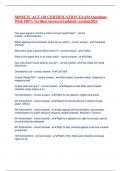Samenvatting
Samenvatting ISE New Products Management, ISBN: 9781260575088 Product Innovation Processes (1ZV30)
- Instelling
- Technische Universiteit Eindhoven (TUE)
Summary of the lecture notes, slides, and course material for the course 1ZV30 in the academic year 2019/2020.
[Meer zien]














